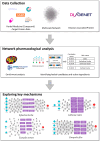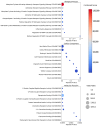Discovery of Herbal Remedies and Key Components for Major Depressive Disorder Through Biased Random Walk Analysis on a Multiscale Network
- PMID: 40076790
- PMCID: PMC11900307
- DOI: 10.3390/ijms26052162
Discovery of Herbal Remedies and Key Components for Major Depressive Disorder Through Biased Random Walk Analysis on a Multiscale Network
Abstract
Major depressive disorder (MDD) is a widespread psychiatric condition with substantial socioeconomic impacts, yet single-target pharmacotherapies often yield responses. To address its multifactorial nature, this study employed a multiscale network analysis of herbs, their active components, and MDD-associated protein targets. Using a biased random walk with restart, we calculated interactions between disease-related and herb-derived targets, identifying herbs highly correlated with MDD. Enrichment analysis further revealed key signaling pathways, including oxidative stress, neuroinflammation, and hormone metabolism, underlying these herbs' therapeutic effects. We identified Ephedrae herba, Glehniae radix, Euryales semen, and Campsitis flos as promising candidates, each containing multiple bioactive compounds (such as ephedrine, psoralen, xanthine, and ursolic acid) that modulate critical processes like oxidation-reduction, inflammatory cytokine regulation, and transcriptional control. Network visualization showed how these herbs collectively target both shared and distinct pathways, supporting a synergistic, multi-target therapeutic strategy. This approach underscores the significance of network-based methodologies in addressing complex disorders such as MDD, where focusing on a single target may overlook synergistic interactions. By integrating diverse molecular data, this study provides a systematic framework for identifying novel interventions. Future experimental validation will be crucial to confirm these predictions and facilitate the translation of findings into effective MDD therapies.
Keywords: active components; herbal medicine; major depressive disorder; multiscale network.
Conflict of interest statement
The authors declare no conflict of interest.
Figures








Similar articles
-
Identifying Herbal Candidates and Active Ingredients Against Postmenopausal Osteoporosis Using Biased Random Walk on a Multiscale Network.Int J Mol Sci. 2024 Nov 16;25(22):12322. doi: 10.3390/ijms252212322. Int J Mol Sci. 2024. PMID: 39596387 Free PMC article.
-
The Mechanisms Underlying the Pharmacological Effects of GuiPi Decoction on Major Depressive Disorder based on Network Pharmacology and Molecular Docking.Comb Chem High Throughput Screen. 2023;26(9):1701-1728. doi: 10.2174/1386207325666220831152959. Comb Chem High Throughput Screen. 2023. PMID: 36045534
-
The potential of natural herbal plants in the treatment and prevention of non-small cell lung cancer: An encounter between ferroptosis and mitophagy.J Ethnopharmacol. 2025 Apr 25;346:119555. doi: 10.1016/j.jep.2025.119555. Epub 2025 Feb 25. J Ethnopharmacol. 2025. PMID: 40015539 Review.
-
Mechanism underlying effect of Chaihu Shugan San on major depressive disorder: a network pharmacology-based study.J Tradit Chin Med. 2021 Apr;41(2):338-348. J Tradit Chin Med. 2021. PMID: 33825416
-
Potential effect of herbal antidepressants on cognitive deficit: Pharmacological activity and possible molecular mechanism.J Ethnopharmacol. 2020 Jul 15;257:112830. doi: 10.1016/j.jep.2020.112830. Epub 2020 Apr 4. J Ethnopharmacol. 2020. PMID: 32259666 Review.
Cited by
-
Plant-derived polyphenolic compounds for managing schizophrenia: mechanisms and therapeutic potential.Front Pharmacol. 2025 Jun 19;16:1605027. doi: 10.3389/fphar.2025.1605027. eCollection 2025. Front Pharmacol. 2025. PMID: 40612741 Free PMC article. Review.
References
-
- World Health Organization COVID-19 Pandemic Triggers 25% Increase in Prevalence of Anxiety and Depression Worldwide. [(accessed on 21 January 2025)]. Available online: https://www.who.int/news/item/02-03-2022-covid-19-pandemic-triggers-25-i....
-
- Cipriani A., Furukawa T.A., Salanti G., Chaimani A., Atkinson L.Z., Ogawa Y., Leucht S., Ruhe H.G., Turner E.H., Higgins J.P.T., et al. Comparative Efficacy and Acceptability of 21 Antidepressant Drugs for the Acute Treatment of Adults With Major Depressive Disorder: A Systematic Review and Network Meta-Analysis. Focus. 2018;16:420–429. doi: 10.1176/appi.focus.16407. - DOI - PMC - PubMed
MeSH terms
Grants and funding
LinkOut - more resources
Full Text Sources

